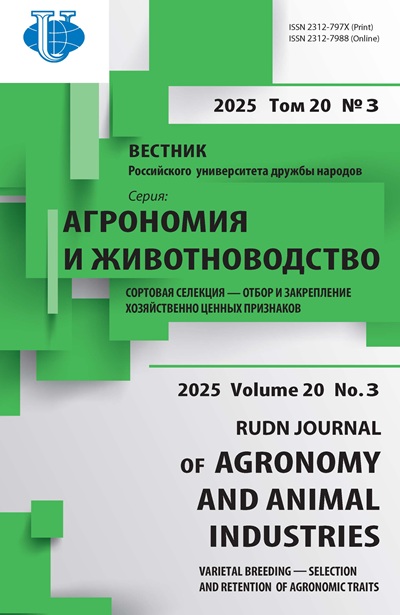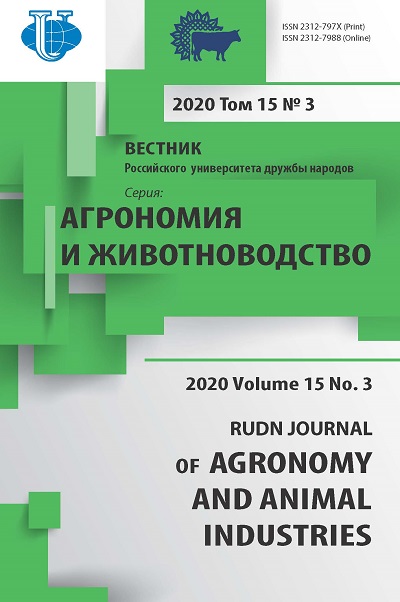Оценка содержания веществ с антиоксидантной активностью в образцах картофеля коллекции исходных родительских форм Федерального исследовательского центра картофеля имени А.Г. Лорха
- Авторы: Гинс Е.М.1,2, Москалев Е.А.1,2, Поливанова О.Б.1,3, Митюшкин А.В.1, Симаков Е.А.1
-
Учреждения:
- Федеральный исследовательский центр картофеля имени А.Г. Лорха
- Российский университет дружбы народов
- Российский государственный аграрный университет - МСХА им. К.А. Тимирязева
- Выпуск: Том 15, № 3 (2020)
- Страницы: 242-252
- Раздел: Морфология и биохимия растений
- URL: https://agrojournal.rudn.ru/agronomy/article/view/19583
- DOI: https://doi.org/10.22363/2312-797X-2020-15-3-242-252
- ID: 19583
Цитировать
Полный текст
Аннотация
В настоящий момент имеются многочисленные доказательства положительной роли антиоксидантов в реакциях, защищающих не только растения, но и человека от окислительного стресса. К растительным антиоксидантам относят фенольные соединения: фенольные кислоты, флавоноиды, антоцианы, а также витамин С. Картофель - одна из наиболее потребляемых культур в мире и может служить многообещающим источником антиоксидантов в питании человека. Целью работы является сравнительное исследование содержания низкомолекулярных антиоксидантов (аскорбиновой кислоты, фенольных соединений, флавоноидов, суммарного содержания антиоксидантов) в 15 образцах картофеля с пигментированной и белой мякотью ( Solanum tuberosum L.) для выявления генотипов с повышенной антиоксидантной активностью. Растения картофеля выращивали в условиях открытого грунта. Исследования проводились в 2019 г. в ФГБНУ «ФНЦ овощеводства» через неделю после уборки урожая. Анализ суммарного содержания растворимых фенольных соединений показал, что практически все исследуемые сорта содержат существенно больше фенольных соединений в кожуре, чем в мякоти. Максимальное количество фенольных соединений выявлено в мякоти картофеля у сортов Монах с фиолетовой мякотью (69,33 мг/100 г сырой массы) и Вымпел со светло-желтой мякотью (67,93 мг/100 г сырой массы). Наибольшее содержание флавоноидов в мякоти отмечено у сортов Жуковский ранний с белой мякотью (12,49 мг/100 г сырой массы) и Тайфун с белой мякотью (11,06 мг/100 г сырой массы). Наиболее высокое содержание аскорбиновой кислоты определено у сортов Гала с темно-желтой мякотью (15,84 мг%), Голубизна с белой мякотью и Ред Скарлетт с желтой мякотью (14,08 мг%). Максимальное суммарное содержание гидрофобных антиоксидантов выявлено у сортов Жуковский ранний с белой мякотью (0,38 мг экв. ГК/г) и Ред Скарлетт с желтой мякотью (0,37 мг экв. ГК/г).
Об авторах
Екатерина Муратовна Гинс
Федеральный исследовательский центр картофеля имени А.Г. Лорха; Российский университет дружбы народов
Автор, ответственный за переписку.
Email: katya.888888@yandex.ru
аспирант, Российский университет дружбы народов; младший научный сотрудник, Федеральный исследовательский центр картофеля имени А.Г. Лорха
Российская Федерация, Московская обл., Люберецкий р-н, пос. Красково, 140051, ул. Лорха, д. 23; Российская Федерация, 117198, г. Москва, ул. Миклухо-Маклая, д. 6Евгений Александрович Москалев
Федеральный исследовательский центр картофеля имени А.Г. Лорха; Российский университет дружбы народов
Email: kmlgwork@mail.ru
аспирант, Российский университет дружбы народов; младший научный сотрудник, Федеральный исследовательский центр картофеля имени А.Г. Лорха
Российская Федерация, Московская обл., Люберецкий р-н, пос. Красково, 140051, ул. Лорха, д. 23; Российская Федерация, 117198, г. Москва, ул. Миклухо-Маклая, д. 6Оксана Борисовна Поливанова
Федеральный исследовательский центр картофеля имени А.Г. Лорха; Российский государственный аграрный университет - МСХА им. К.А. Тимирязева
Email: polivanovaoks@gmail.com
кандидат биологических наук, научный сотрудник
Российская Федерация, Московская обл., Люберецкий р-н, пос. Красково, 140051, ул. Лорха, д. 23; Российская Федерация, г. Москва, 127550, ул. Тимирязевская, д. 49Алексей Владимирович Митюшкин
Федеральный исследовательский центр картофеля имени А.Г. Лорха
Email: zakazvniikh@mail.ru
кандидат сельскохозяйственных наук, ведущий научный сотрудник-заведующий лабораторией селекции сортов для переработки
Российская Федерация, Московская обл., Люберецкий р-н, пос. Красково, 140051, ул. Лорха, д. 23Евгений Алексеевич Симаков
Федеральный исследовательский центр картофеля имени А.Г. Лорха
Email: vniikh@mail.ru
доктор сельскохозяйственных наук, главный научный сотрудник-заведующий отделом экспериментального генофонда картофеля
Российская Федерация, Московская обл., Люберецкий р-н, пос. Красково, 140051, ул. Лорха, д. 23Список литературы
- FAOSTAT. Crop production. Available from: http://www.fao.org/faostat/en/ [Accessed 18th April 2020].
- Andre CM, Ghislain M, Bertin P, Oufir M, del Rosario Herrera M, Hoffmann L, et al. Andean Potato Cultivars (Solanum tuberosum L.) as a source of antioxidant and mineral micronutrients. Journal of Agricultural and Food Chemistry. 2007; 55(2):366-378. doi: 10.1021/jf062740i
- Fan G, Han Y, Gu Z, Gu F. Composition and colour stability of anthocyanins extracted from fermented purple sweet potato culture. LWT - Food Science and Technology. 2008; 41(8):1412-1416. doi: 10.1016/j. lwt.2007.09.003
- Kita A, Bąkowska-Barczak A, Hamouz K, Kułakowska K, Lisińska G. The effect of frying on anthocyanin stability and antioxidant activity of crisps from red- and purple-fleshed potatoes (Solanum tuberosum L.) Journal of Food Composition and Analysis. 2013; 32(2):169-175. doi: 10.1016/j.jfca.2013.09.006
- Young IS, Woodside JV. Antioxidants in health and disease. J Clin Pathol. 2001; 54(3):176-186.
- Skrovankova S, Sumczynski D, Mlcek J, Jurikova T, Sochor J. Bioactive compounds and antioxidant activity in different types of berries. Int J Mol Sci. 2015; 16(10):24673-24706. doi: 10.3390/ijms161024673
- Hercberg S, Galan P, Preziosi P, Alfarez MJ, Vazquez C. The potential role of antioxidant vitamins in preventing cardiovascular diseases and cancers. Nutrition. 1998; 14(6):513-520. doi: 10.1016/S0899- 9007(98)00040-9
- Al-Saikhan MS, Howard LR, Miller JC. Antioxidant activity and total phenolics in different genotypes of potato (Solanum tuberosum L.). Journal of Food Science. 1995; 60(2):341-343. doi: 10.1111/j.1365-2621.1995. tb05668.x
- Hacişevkı A. An overview of ascorbic acid biochemistry. J Fac Pharm Ankara. 2009; 38(3):233-255.
- Koyuncu MA, Dilmacunal T. Determination of vitamin C and organic acid changes in strawberry by HPLC during cold storage. Not Bot Horti Agrobot Cluj. 2010;38(3):95-98. doi: 10.15835/nbha3834819
- Lachman J, Hamouz K. Red and purple coloured potatoes as a significant antioxidant source in human nutrition - a review. Plant Soil Environ. 2005; 51(11):477-482.
- Lewis CE, Walkel JR, Lancaster JE, Sutton KH. Determination of anthocyanins, flavonoids and phenolic acids in potatoes. I: Coloured cultivars of Solanum tuberosum L. J Sci Food Agric. 1998;77(1): 45-57. doi: 10.1002/(SICI)1097-0010(199805)77:1<45:: AID-JSFA1>3.0.CO;2-S
- Goyer A, Picard M, Hellmann HA, Mooney SL. Effect of low temperature storage on the content of folate, vitamin B6, ascorbic acid, chlorogenic acid, tyrosine, and phenylalanine in potatoes. Journal of the Science of Food and Agriculture. 2019; 99(10):4842-4848. doi: 10.1002/jsfa.9750
- Hajšlová J, Schulzová V, Slanina P, Janné K, Hellenäs KE, Andersson CH. Quality of organically and conventionally grown potatoes: Four-year study of micronutrients, metals, secondary metabolites, enzymic browning and organoleptic properties. Food Addit Contam. 2005; 22(6):514-534. doi: 10.1080/02652030500137827
- Burg P, Fraile P. Vitamin C destruction during the cooking of a potato dish. LWT-Food Science and Technology. 1995; 28(5):506-514. doi: 10.1006/fstl.1995.0085
- Burgos G, Auqui S, Amoros W, Salas E, Bonierbale M. Ascorbic acid concentration of native Andean potato varieties as affected by environment, cooking and storage. J Food Comp Anal. 2009; 22(6):533-538. doi: 10.1016/j.jfca.2008.05.013
- Rytel E, Lisińska G. Changes in the content of vitamin C in potato tubers during the cooking and processing to fried and dried products. Zywn Nauk Technol Ja. 2007; 6(55): 186-197.
- Grudzińska M, Czerko Z, Zarzyńska K, Borowska-Komenda M. Bioactive Compounds in Potato Tubers: Effects of Farming System, Cooking Method, and Flesh Color. PLoS ONE. 2016; 11(5): e0153980. doi: 10.1371/ journal.pone.0153980
- Ainsworth EA, Gillespie KM. Estimation of total phenolic content and other oxidation substrates in plant tissues using Folin-Ciocalteu reagent. Nature Protocols. 2007; 2(4):875-877. doi: 10.1038/nprot.2007.102
- Garg D, Shaikh A, Marar T. In-vitro antioxidant activity and phytochemical analysis in extracts of Hibiscus rosa-sinensis stem and leaves. Free Radical Antioxidants. 2012; 2(3):41-46. doi: 10.5530/ax.2012.3.6
- Сапожникова Е.В., Дорофеева Л.С. Определение содержания аскорбиновой кислоты в окрашенных растительных экстрактах йодометрическим методом // Консервная и овощесушильная промышленность. 1966. № 5. C. 29-31.
- Гинс М.С., Гинс В.К., Байков А.А., Рабинович А.М., Кононков П.Ф., Солнцев М.К. Содержание антиоксидантов в лекарственных и овощных растениях, проявляющих противоопухолевую активность // Вопросы биологической, медицинской и фармацевтической химии. 2013. Т. 11. № 2. С. 10-15.
- Гинс М.С., Гинс В.К., Байков А.А., Романова Е.В., Кононков П.Ф. Методика анализа суммарного содержания антиоксидантов в листовых и листостебельных овощных культурах. М.: РУДН, 2013. 40 с.
- Visvanathan R, Jayathilake C, Chaminda Jayawardana B, Liyanage R. Health-beneficial properties of potato and compounds of interest. Journal of the Science of Food and Agriculture. 2016; 96(15):4850-4860. doi: 10.1002/jsfa.7848
- Lachman J, Hamouz K, Orsak M, Pivec V, Dvorak P. The influence of flesh colour and growing locality on polyphenolic content and antioxidant activity in potatoes. Sci Hort. 2008;117(2):109-114. doi: 10.1016/j. scienta.2008.03.030
Дополнительные файлы















